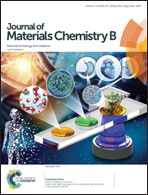Polycarbonate-based core-crosslinked redox-responsive nanoparticles for targeted delivery of anticancer drug†
Abstract
We reported a facile and efficient strategy for the construction of polycarbonate-based core-crosslinked redox-responsive nanoparticles (CC-RRNs), which can efficiently regulate the drug loading content and redox-responsive drug release. A series of CC-RRNs for delivery of doxorubicin (DOX) were synthesized by the click reaction between alkyne-bearing amphiphilic block copolymer PEG-b-poly(MPC)n (PMPC) and azide-terminated α-lipoic acid derivative (LA) and 6-bromohexanoic acid derivative (AHE) at different ratios, followed by introduction of crosslinked networks under a catalytic amount of dithiothreitol (DTT). Dynamic light scattering (DLS) experiments showed that the CC-RRNs presented more excellent stability over non-crosslinked unresponsive nanoparticles (NC-URNs) under physiological conditions. Interestingly, the DOX loading content of nanoparticles (NPs) increased as the proportion of LA moieties increased, and the maximum value was up to 20.0 ± 0.6%, close to the theoretical value of 23.1%. The in vitro redox-responsive release of DOX and MTT assays confirmed that the ratio of LA-to-AHE of PMPC-based polymers not only determined the ultimate drug release of DOX-loaded CC-RRNs in a reductive environment, but also dominated the cytotoxicity towards HepG2 cells. Confocal laser scanning microscopy (CLMS) and flow cytometry further proved the enhancement of cellular uptake and tumor accumulation. This facile strategy overcomes tedious fabrication procedures for drug nanocarriers, offers an opportunity for regulating the functionality of NPs, and thus paves the pathway for scale-up production of biodegradable drug carriers with biocompatibility, stability and targetability.



 Please wait while we load your content...
Please wait while we load your content...